Looking for a few good men (and women)!
In LBS, there is a strong tradition of student-led school trips to their home countries for fun e.g. Japan, Egypt, Lebanon, skiing in Switzerland, or for work e.g. LBS Media trek in LA, commodities trek in Geneva, finance trek to HK/NY, industry trek to Shanghai etc.
I had already organised a trek for work, so I thought it was time to do one for play as well – the LBS North Pole trek.
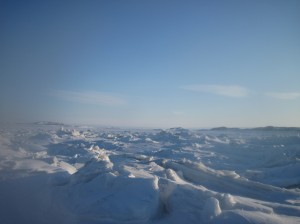
Ths is the post that started it all –
On 05/05/2011, Choong Luen Lien <xxx@london.edu> wrote:
Felt that your summer IBD internship was too easy and seeking bigger challenges? Think that “global warming” is a key issue confronting us? Missed a spot on the Portugal Trek?
Wanted: Team-players for an expedition to the North Pole in March-April 2012
Dear LBS friends,
Following in the time-honoured tradition of 2nd year MBAs to “slack off” before they graduate, sorry, I meant enrich their life experiences, I am thinking of organising a “North Pole Trek” in March – April 2012.This would involve skiing the last 100km to the north pole in freezing temperatures, with uncertain ice-cover due to global warming. With the moving ice, we could ski a whole day and be further away than when we started, not to mention the risk of falling through the ice or becoming a snack for a polar bear.
This is clearly a VERY VERY significant financial, time and physical investment required in order to train, secure sponsorships and prepare logistics. That said, anyone, regardless of gender or experience is welcome to apply (Corporate turnaround bankers and lawyers especially so, as I hear they have hearts that are used to the cold).
If you are prepared to commit your time and energy, to pull more than your fair share of the weight and to suffer together with good grace, then join me in forming a team of 4 to fly the LBS flag together at the geographic North pole, and leverage our “suffering”, and enriching life experience, for a good cause.
In terms of my own experience, I have been on teams that climbed in the Himalayas, raced in multi-day endurance events and dealt with physically high-stress situations at work. I am interested in team-mates that are able to deal with adversity and can maintain a good sense of humour even when being chased by a polar bear.
Write to me if your childhood dream was to visit Santa Claus’ workshop and we can fulfil it – From an Operations Management perspective, I guarantee his factory will put Jaguar or Amazon to shame (2 billion customers fulfilled over a 24 hour period with no dropped orders)!
Project management
As Bert de Reyck, our amazing lecturer in Project Management class taught us, a good work break-down structure and identification of the critical path is essential to the success of any project, as is a clear prioritisation of time, scope and cost.
This was the project breakdown that we plan to use.

So training starts now
Finally done with my 3rd block week, before heading into the last 3 courses of my MBA life!
It has been a hectic few months since the idea began – intense consulting internship in Singapore (ranked one of the top firms to work for by Fortune magazine, but hours were still challenging), exchange programme in China with full-time recruitment and a part-time internship, 3 block weeks, Christmas break in the Philippines with the gang and back home to see family for a few days.
Time to put the plan into action!
My first tyre
Walked all over the face of London trying to find a proper tyre store, before eventually getting one in Camden. Pretty excited, this is it!
Lots of strange stares as I dragged it back to LBS. Many people commented that I looked “tyred”. Others asked me what I was training for – my usual reply – “Can’t afford a car, could only get a tyre.” Or one that my soon-to-be-married friend suggest to me – “I hear that marriage can be a real drag, so I’m getting in some practise now.”
The weather in London
Strange that London in January is so unseasonably warm, makes it difficult to train. Lots of laps around Regent’s Park.

Rain or shine, sick or not …
Been really sick this past week, can’t hold any food in the stomach, so training has to be done when hungry, then out to drag tyres for an hour or two before trying to eat, then curled up in bed for a few hours after that.
The skiing in London is great
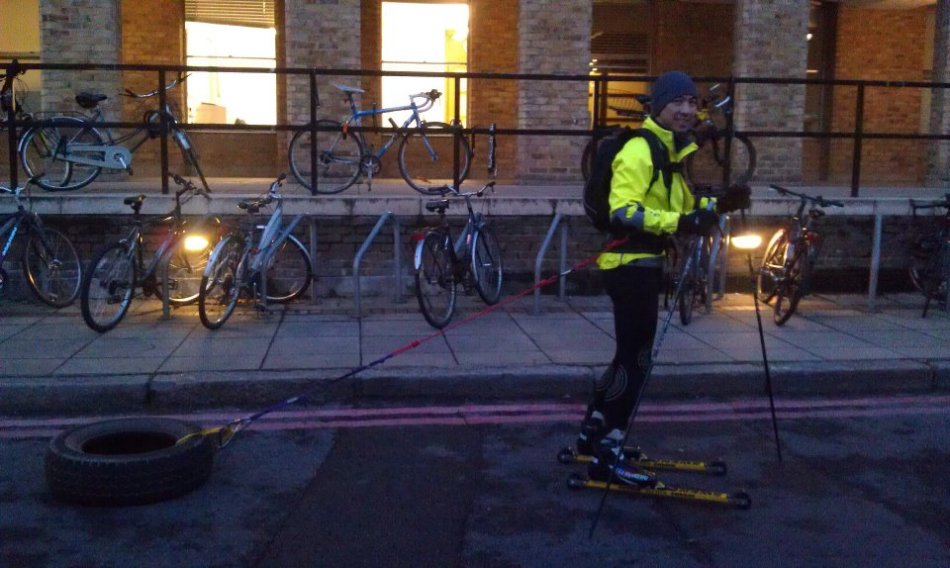
So its not always easy to get the right snow conditions in London right for cross-country skiing, so I have to make do with roller-skis. Its great fun, but a bit slow when you have a tyre strapped to you. (Thanks for the photo Carolyn).
Love this comment by Jon on Facebook –
-
 John PP 10,000 BC, the wheel invented in the Neolithic era to facilitate movement of heavy objects.
John PP 10,000 BC, the wheel invented in the Neolithic era to facilitate movement of heavy objects.
2012 AD, a Cambridge mathematician with an MBA from LBS forgets how to use one.February 11 at 3:08pm · Like · 1
1
Somehow I can’t help but feel that training like this is similar to what we do in the MBA – take abstract models that “kind of” simulate the challenge of reality, and tell ourselves that we still capture the important essence despite the simplifications.
So a tyre for a sled, because it is just about weight and drag, and roller-skis to simulate cross-country ski action. =0
But what to do, the snow in London isn’t always great for skiing.

Arctic Circle Training
I just got back from 12 days on Baffin Island, (super far north Canada), which is in the Arctic circle. Training with polar adventurers extraordinaire – Matty McNair and her two kids, Sarah and Eric McNair-Landry (who hold records for being the youngest to reach the South Pole, 596km kite-skied in a day etc.)
This was a good introduction to the Arctic weather. While I had been in similar cold before, on a mountain, it usually started off cool and got colder the higher one got – which gave one time to acclimatise, or at least turn back. At Iqaluit, the instant I stepped off the plane, we were down to -30°C temperatures instantly, thank goodness I had some warm clothes with me.
In a crowd like this, there was a bunch of amazing people staying at the Northwinds lodge – Irish explorers and a Japanese man about to do a solo expedition to the North pole. A few of the guests and visitors had also summited Everest. It was a real privilege to see the systems that they used, and debate the merits and trade-offs of the different types of gear to bring along.
Every night, I was out in the tent at the back, getting used to the weather, and trying out different sleep systems.The first few days were theory, where I reconciled my prior knowledge and experience from climbing, adventure-racing, work to the requirements of a polar environment.
I think respect for the environment is key – hence the need to come for training and learn from those that have successfully done it.
Great fun, had a chance to go on a dog-sled ride, kite-ski, but mainly learn to cross-country ski with a pulk and live comfortably in that environment.The photos don’t do justice to the excitement, speed and sheer fun of running with the big dogs!
Of course, it wasn’t all fun and games. The main learning was in the field, with a 7 day mini-expedition with Sarah. We navigated, cooked and even went for a swim.All through-out, the weather was incredibly cold, and numb fingers and toes were pretty much par for the course. Holding anything – food, gear, cameras, all soaked away precious heat from the fingers, while sweat cooled and turned to ice, lowering the body core temperature. The sleds were loaded down with all our gear, and had an extra 80lbs of dog-food, just in case they weren’t heavy enough. Many people think that ice is smooth, but with the tidal action (we are skiing on frozen sea-ice) and wind, they form incredible rough patches hundreds of meters to several km wide that are an incredible pain to cross.

Many people say that jumping from a plane is a unique manifestation of a suicidal wish (having done it quite a few times, I would agree). The same goes for taking a dip in water when the air temperature is -50°C with wind-chill and frost-bite hits naked skin in 30seconds. This was to practise crossing patches of open water that could not be avoided

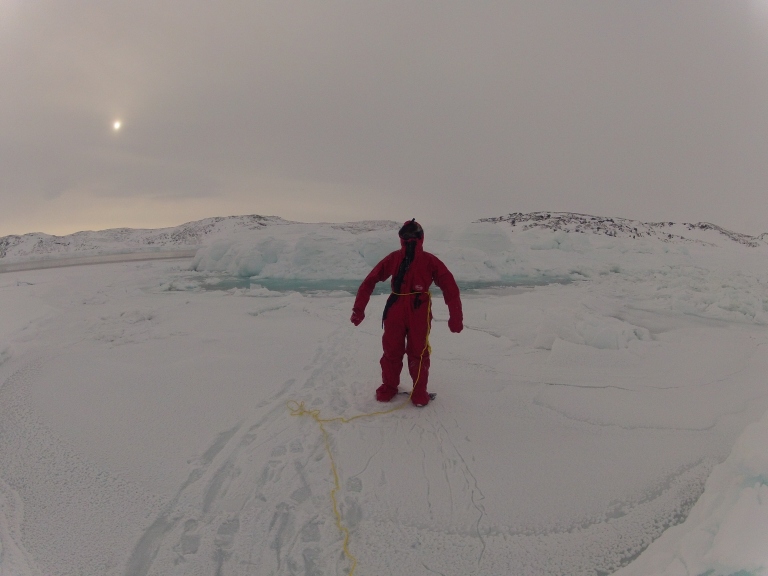
Me in my bathing suit! Worst thing was springing a small leak, and getting wet feet! A little bit worse than in London.
The final evolution was to make my own way back, once Sarah was convinced I wouldn’t blow things up when left alone. Armed with a shot-gun, tent, food, satellite phone and fuel, I took my bearings with the compass and sat off back to civilisation. The way was pretty far, and the howling wind on the second day made it almost impossible to set-up tent, or to sleep. The violent winds had me thinking all night about the tent collapsing, especially while the stoves were running. Not happy thoughts.
On the final day – I had to make it back to Matty’s by a fixed time, because I had a flight to catch. I had enough time to shower, change and then hop on the plane. A short nap later, I was back in civilisation, having a good meal.
Surreal indeed.
PS – many people ask about going to the toilet in such conditions. I can only say this – if you are one of those blessed with huge capacity, then you’re the lucky one.
PPS – so why do this – answers below
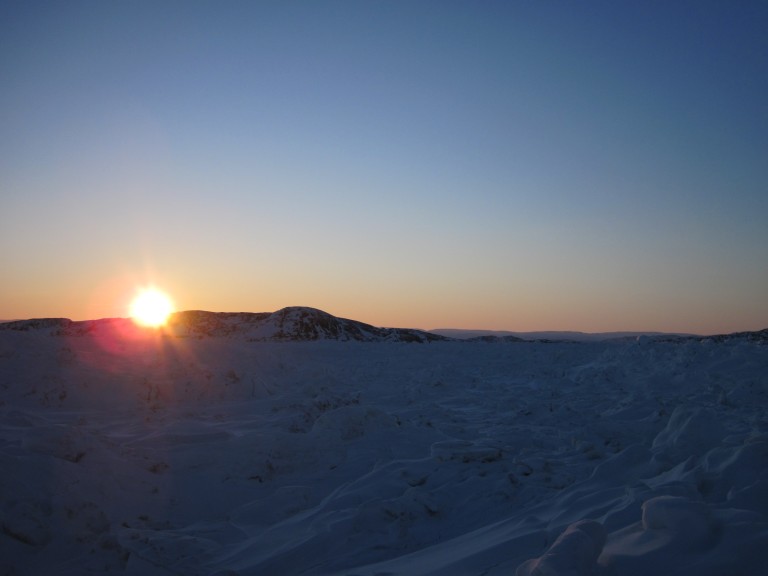

New addition to the family!
As part of the learning from my Canada trip, I realised that my tyre wasn’t heavy enough, hence I decided to add another one to the mix. It was strange walking up to the garage and asking for another tyre.

Great guys at the LBS maintenance team helping me drill a hole in my new truck tyre!
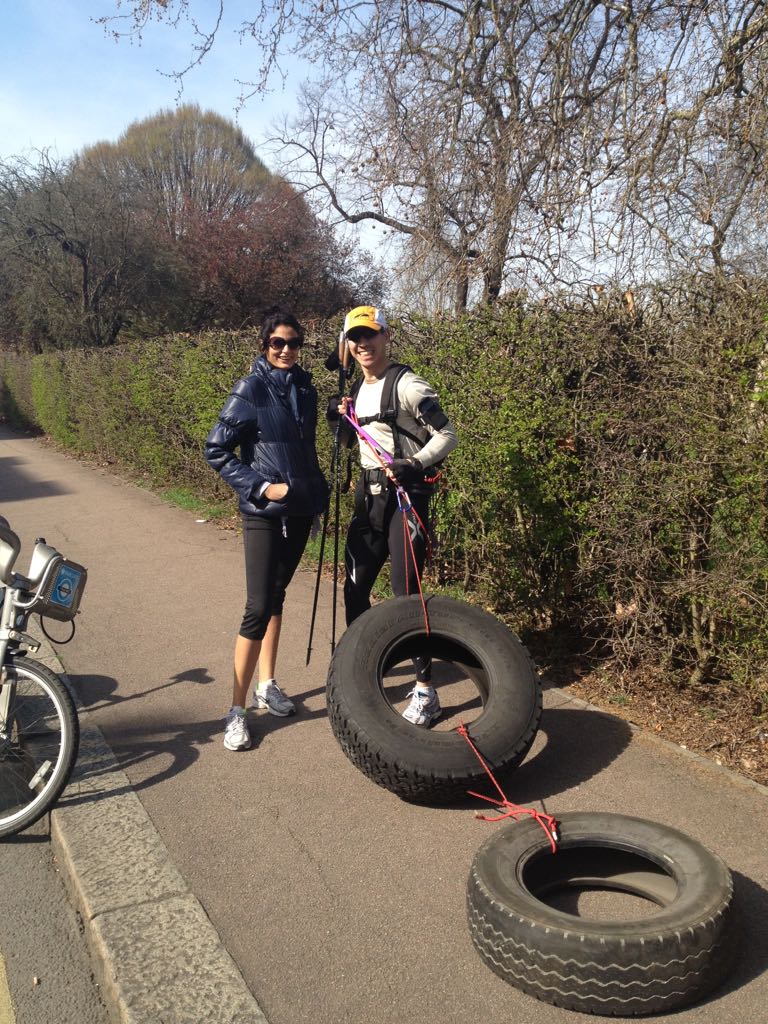
Taking the big one and the little one out for a walk, they’re heavier than they look
Life potential
As my MBA comes to a close, I find that my friends and I spend quite a lot of time trying to make sense of the past two years here. The classmates I have at the London Business School (until recently ranked #1 globally by the Financial Times 3 years running), are some of the most diverse, talented and amazing people around.
When you talk about the global elite, these guys are it. From Olympic athletes, to financial wizards to singers and entrepreneurs, this is a driven group that strives to squeeze every drop of meaning out their lives, and maximise their life potential. I guess that is the main reason they came to LBS (that and to party it up in London).
That is not a very different goal from MENCAP.
There are 1.5 million people with learning disabilities in the UK. MENCAP works to change laws, provide services and training so that people with learning disabilities can choose how they live and to maximise their life potential.
The way I see it, the goals that we have are the same – to become better people, to challenge ourselves, to be independent, to be happy, these are constant in direction; though the actual heights achieved may differ.
That is why I am raising funds for Mencap, and I hope you can help me achieve my goal.
Tracks on the pavement
So there is a Chinese proverb that says “若要功夫深,铁杵磨成针“ which roughly translates to – if you persevere, you can grind an iron bar into a fine needle. That hasn’t quite happened yet, but I can already see the marks on the pavement of Regent’s park where my tyre dragging has left scratch marks.
Beautiful day out training today. Will post pix later.
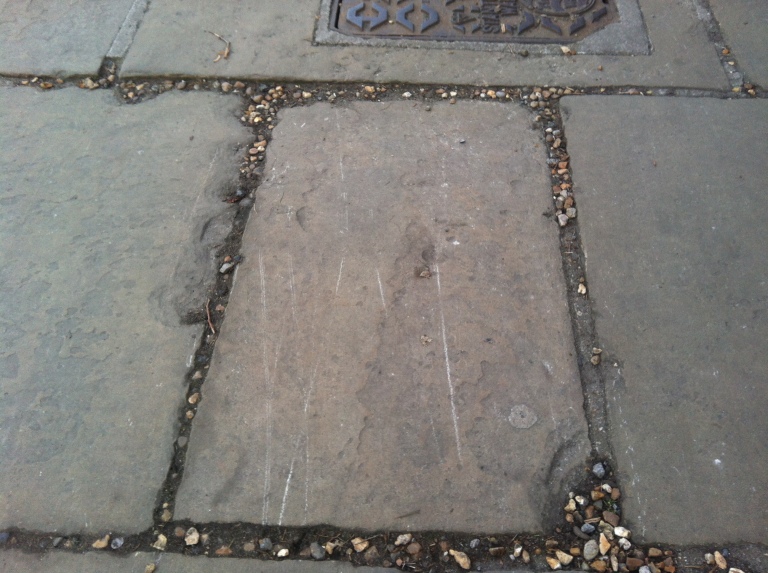
What I think about when training?
To the consultants out there – here’s a estimation case for you – How many consultants does it take to train for the North Pole? Five. One to actually do the tyre-dragging, and a case-team of four to advise him to upgrade to sled-dogs!
Haruki Murakami has a book titled “What I talk about, when I talk about running”. There, he writes very lyrically about his relationship with running, and the Zen he experiences when racing or training.
In a much more prosaic vein, friends have asked me what I do or think about when I’m dragging tyres around Regent’s Park. The short answer – not very much, other than the fact that I’m tired, I’m hungry and wondering when the next rest break would be.
I recall when I first started training for an endurance event or mountain-climbing, I would just do what I needed to do – whether it was midnight gym sessions or running with a 25kg pack through the trail at night. No entertainment/music required. Even when I was clocking 7 hours on the bike while training for a triathlon, I could just watch my instruments and stay focussed on the three numbers of cadence, heart-rate and speed without listening to any music. And mind you, Singapore being the size it is, 7 hours means you are doing many laps around the same area.
As I got older, I must have gotten weaker/more easily bored or distracted. When training to go to the Himalayas in 2010, I clocked significant mileage climbing stairs at an apartment block near my house. After a while, I could recognise which apartments had kids learning to play the piano (badly), which ones had good cooks (tantalising smells), and which ones enjoyed watching Korean soap operas. It was also during this period that I started playing music to help get by the monotony. (80s pop rules. Sadly, many of these classic songs by groups such as Wham, Bananarama, Roxette etc. are alien to the younger generation.)
Laps around Regent’s Park are pretty much the same. You learn to watch out for dog poop, you figure out the areas where there is more drag, and travelling at such a slow speed, you occasionally have time to take things in – like the transient blooming of the cherry blossoms. But mainly, I focus on form – what my body is telling me – in cycling that would be the equivalent of monitoring the measures of cadence, speed and heart-rate. While you’d like the body to be on auto-pilot, and it can do so for stretches at a time, it is important to realise that even in mundane repetitive tasks, significant focus and attention is required to prevent injury and to aid in optimisation, which pays off in the long run.
Podcasts are amazing as well – not something I would usually have the time to do, but hey – it’s marginally more interesting than watching pavement. LSE Ideas is good, Roy Baumeister has a good talk on Willpower – how it is like a muscle in that it can be
- Fatigued when resisting temptation
- Tries to conserve its reserves when depleted, and
- Can improve with more use.
Sometimes, it is just nice to be able to look at the trees.

Packing for holidays – kitchen sink to be included?
So one of the fun parts of an expedition is the final packing, when you try to figure out if you have everything on the list, and whether it will all fit into the bags. It can be considered an optimisation problem where you have to trade-off weight/cost/flexibility.
Usually, option value wins, so you bring everything that you have, with tons of spares, which you can leave behind if you want. This is a picture of my current pack-out. Space in London being at a premium, I’m doing it in my room, which is not ideal.
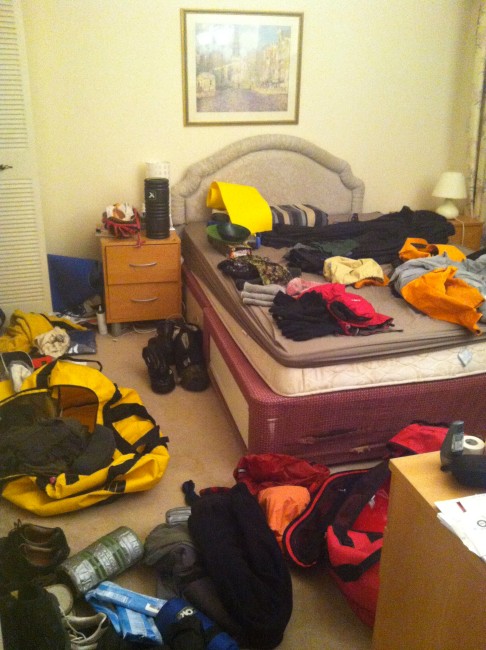
Every packing is different, because the whole philosophy behind the trip is different – in polar expeditions, volume is cheap, and weight is relatively cheap, meaning that it is easy to carry bulky things. That is certainly not true for climbing for example, where both weight and volume have to be minimised for efficiency.
Compare that to this one for one of my adventure races – when you have to do multiple evolutions in a couple of days, you bring bike plus all the spares (8 spare tubes in this instance), kayak gear (paddles and life vests), running gear, climbing gear etc, plus food and night equipment – you have to be pretty methodical about it, and make sure the checklist is complete.
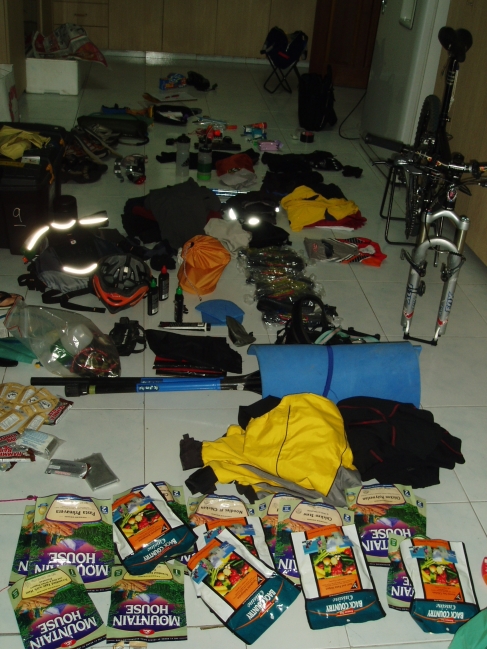
As my Himalaya climbing trip went, any single missing or broken item could cause a cascade of problems so it was critical to be spot-on with everything. E.g. missing lip balm mean that lips would crack, so you eat more slowly/eat less, which would lead to you getting weaker = not summitting. With the end-point of every equation being a reduced chances of success, it pretty much meant that you would be very much disciplined to do everything it took to succeed.
On this expedition, just the gloves I’m bringing include
- 2 pairs of liners,
- 2 pairs of fleece,
- 1 pair thick ski working gloves,
- 1 pair down summit mitts,
- 1 pair super overmitts.
So next time your partner complains about over-packing, remind them that the success of the holiday is at stake, and increased option value is the only way to do successful risk mitigation!
Final Prep – Last post for a while…
First off, a big thank you to all the friends who have given me words of encouragement and support. Many thanks also for your contributions and donations to MENCAP!
As final prep, I spent Monday afternoon at the Robert Scott South Pole exhibition at the Natural History Museum in Kensington. Highly recommended!
For those not familiar with the story, 100 years ago, Robert Scott (British navy) and Roald Amundsen (Norwegian polar explorer), were in a race to be the first men to reach the South Pole. As Scott described simply in his expedition prospectus: The purpose of the expedition is to reach the South Pole, and to secure for the British Empire the honour of this achievement. Simply stated and simpler times, but lofty aims. Things that we can all resonate with still nowadays.
As history would have it, Amundsen was the winner then, reaching the South Pole in Dec 1911: the following photograph shows them happy after their success.

For Scott however, his team arrived at the pole a month later in Jan 1912 bitterly disappointed at being beaten to the prize. Even worse was that on the home ward journey, their team of 5 all froze to death, as they had run out of food, being stopped by extreme bad weather only 20km from their food cache. The only thing to commemorate them was the following snow cairn, erected by the search party from base-camp that could only retrieve their diaries and belongings 6 months later, when summer broke in the Antarctic.

The British party left no man behind, dragging along their sick and wounded even when they were running short on food. In similar spirit, one of their wounded members, Titus Oates, who suffered from bad frost-bite sacrificed himself when he walked out barefoot into a blizzard, so that he would not be a hindrance to the team. His parting words were “I am just going outside and may be some time.”
This spirit of the Scott exhibition reminds me of a quote I once read by a British sergeant – Our officers are there to show us how to die. This was not meant unkindly, but descriptive of the nobility and perseverance even in the face of extreme privation, which Scott’s expedition fully captures. I wondered whether Titus’ action was merely a gesture – too little too late, and if he had done it earlier, it would have changed their overall chances of success. But given the solidarity in the team, I believe that if there was still a glimmer of hope, the rest would certainly not have allowed him to sacrifice himself. Talk about team-work.
Today I had the chance to see the Norwegian point of view at the Fram museum. It houses the ship (Fram) that Amundsen used to explore the North and South pole regions. Their story was one of thorough preparation (living years with the Eskimos), discriminating team selection (champion skier), good strategy (sled dogs for locomotion) and above all, a single-minded pursuit of one goal.
It is hard not to compare the two expeditions, seeing that they had the same goals but such different outcomes. Having seen both the British and Norwegian exhibits, I think that the wikipedia entry is pretty accurate.However, from experience with MBA case-studies, I’m careful of drawing simple conclusions in hind-sight. It would be easy to say that one team was ill-prepared, but it could also be argued that Scott, with his flair for writing, and tragic end had a greater impact than Amundsen (MBA moral – marketing is more important than actual product quality). After all, for every Honda Case A story, there is always a revisionist Honda Case B. And anyway, these points are moot – these men have passed on, it was just a question of when.
What is not in doubt however, is that they made a wager and were willing to stake their lives on the outcome. They spent years preparing for the expedition, and to their minds, made what seemed like the best choices at that point in time. They both gambled – one survived, one failed.
The sheer human effort that the Scott team made in dragging their sledge is unbelievable. Unfortunately, despite the material science wizardry that people like Mr. Dow and Mr. Gore (Tex) have come up with over the years, modern polar travel is still a very similar enterprise nowadays.
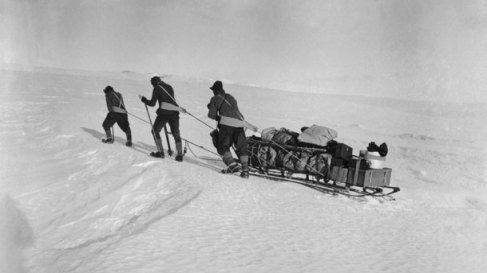 .
.
One thing is for certain – with Scott as an examples of fortitude, if one faces conditions that are less challenging, there can be no excuse to quit. Similarly, with an example of dedication like Amundsen, unless one puts in the same amount of effort, there can be no excuses in the event of failure.
Things to think about.
Last post for a while, chat with everyone when back.
Blue skies.
The Journey … and the destination

Imagine skiing over thin ice, pulling a 100+ lbs sled, dealing with freezing cold, ice breaking under your feet and tents, polar bear sightings. All these and more were challenges on this expedition.
1. It’s Great to be back! First off, it’s really great to be back in civilisation (Defined as any place with a flushing toilet). Sorry it’s been so long writing this post – getting back into the real world has been a big challenge, with classes, second year projects (thanks Nik and Ben for being so patient while I was training and away on this trip!) and other school commitments. I arrived back at my apartment past midnight on a Sunday evening, and was sitting in the class-room seven hours later. Ouch.
2. Thanks for all the support – Yes, I made it, with all 21 digits intact! The biggest thanks to all the friends, classmates and family that supported me through this endeavour, gave me words of encouragement and pats on the back during my training and also supported my adopted charity.
 (MENCAP donations hit the GBP$5000 mark, thanks!)
(MENCAP donations hit the GBP$5000 mark, thanks!)
Big thanks especially to my brother BL, whose big donation helped us achieve the target of GBP$5000 for MENCAP. So for those of you that think that there is no future in hedge funds, think again.
Rachel from MENCAP also sends her thanks to everyone for the programs they’ll be able to fund with this!
The following are some of the main questions people were interested in:
3. How did you get there?
The trip started from London to Oslo to Svalbard (780 North, where they have the seed vault that is a plant version of Noah’s Ark and more polar bears and snow-mobiles than people) to Barneo, which is a science station built by the Russians on Arctic ice that exists for only one month a year. Setting up the station is a whole military operation in itself! There are some amazing videos of how the specialists free-fall in with the equipment and level the airfield. Next time you complain about a bumpy ride, think of these guys. See http://www.barneo.ru/2011.htm for details.
 (Svalbard water-front property)
(Svalbard water-front property)
(Big John in front of polar bear crossing sign – Svalbard more polar bears than people)
It is hard to imagine but the whole air-strip, and ice-station is built on top of moving ice that floats over the Arctic ocean. Underneath the few metres of ice is 4000m of icy-cold sea water down to the sea floor.

(Keynesian construction stimulus package – Arctic style)
4. Flying in to Barneo
Once we got into Barneo, there was immediately a high-stakes discussions on the route and plan of attack, as well as what time the helicopter to drop us off would fly. The three main factors in military operations are often Time, Terrain and Enemy Action.

(Rick Sweitzer – Our intrepid leader and boss of Polar Explorers company)
a. Time – Given that the Barneo station had a hard dead-line of Apr 23 after which the whole science station would have to be dismantled and flown out because the warming weather posed a risk of the ice under the station melting. This gave us added pressure to arrive at the North Pole on time. One good thing was that with 24hours of daylight, if push came to shove, we could just log longer hours on our skis.

(Barneo ice-camp – An amazing example of great Russian hospitality and ingenuity. All this has to go by the 23rd of April)
b. Terrain – One of the key challenges in Arctic travel was that we were traveling over moving ice. This meant that when the ice-plates pulled apart, it could create huge stretches of open water that had to be swum around or skied around. When the ice pushed together, it created pressure-ridges of small hills that were incredibly tough to get around. The shifting ice could move as fast as we skied, so on bad days, we could be on a tread-mill, moving the whole day without getting any nearer to the North Pole.
 (Michael crossing a small lead of open water)
(Michael crossing a small lead of open water)

(Me chopping a path through the rough ice – Note the flipped over sled)
There was one time as we were crossing thin ice that the whole ice piece I was on cracked and began to sink, with my right leg following it into the water. Talk about getting cold feet! Thankfully I managed to get out, and powder snow helped to soak up most of the water. But falling into a thin lead is one of the key areas of danger on a Polar expedition.
Another time, after we had just reached the pole and had our tents set up and were settling in to sleep, we were serenaded by the grinding of the ice plates moving. On checking, we found a crack had opened up right next to our tent, forcing us to get up from our sleeping bags, put on our clothes, pack up and move tents otherwise the tent could have gone into the water and sunk to the bottom of the ocean – literally falling property value or sinking prices.
c. Enemy Action – Ursa Maritimus (Polar Bear)
When people think of polar bears, this is the mental image that they have, courtesy of Coke’s media campaign over the years.

(What most people think when they think of polar bears)
However, the reality is that the undisputed top of the food chain around polar regions is Ursa Maritimus – reflecting its ability to swim and survive in these regions. Growing up to 650kg, with the largest recorded specimen topping 1 Ton, polar bears can sprint up to 40km/h and swim 4km/h, a good sight faster than humans.
The only advice when meeting a polar bear is to make sure you can run faster than your team-mates =0
Here is my good friend Big John posing – this bear weighed only 350kg when it died – imagine an animal three times the size!

On our first day of the expedition, another team was being inserted by helicopter, and they spotted a polar bear mom and her cubs.
 (Photo of mama bear and her two cubs, courtesy of Anastasia from the Norwegian team)
(Photo of mama bear and her two cubs, courtesy of Anastasia from the Norwegian team)
Not long after that, we came across a set of polar bear paw-prints. To see other signs of life in the Arctic wilderness was highly disconcerting – you can imagine that the shot-gun and pistols were at the ready after that!
5. The Team
Overall, there were 7 of us in the team, as well as 3 guides. Rick, Keith and Vern were our amazing guides from Polar Explores, while, Lu Xiaohua and Li Jianxiong were from China, Mike Stringfellow from Australia, Alex and Simon Hearn a father/son team from UK and Big John Dahlem, my buddy from Everest.

There were so many funny stories to tell about the team, and way too much naked flesh for such a cold climate (what with frostbite risk and all) and tattoos being exposed but I guess what happens at the North Pole, stays at the North Pole so I’m not posting any of these incriminating photos.
The cultural diversity was also manifested in the kind of alcohol brought on the trip –
One of the exciting photos that didn’t pass censorship is of Simon and Alex, who stripped themselves completely naked when we finally reached the pole, covering up their man-bits with the Union Jack as well as their regiment flag (Royal Scots Dragoons).
6. Reaching the Pole
After a long journey, we finally reached the pole on April 18th at 430pm. The final going was incredibly tough, taking us more than an hour to cover the final few hundred metres. Once near there, we also had to wander around trying to track the exact spot on GPS.
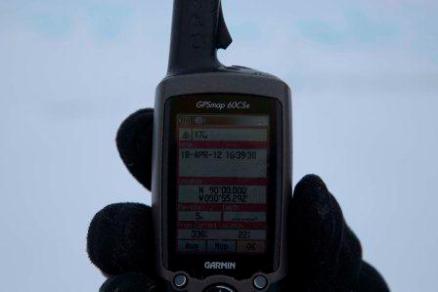
(GPS reading 90 degrees North. Longitude is where it gets confusing)
After such a long journey it was great to finally reach our destination! Within a few moments however, we had drifted on, and we were already starting to move away from the North Pole.

7. The North Pole – What does it mean to you?
It is inevitable to make comparisons with Everest when I was on the polar expedition, and I guess there are two possible views that people can take of the world:
Life is like a mountain
Many people use mountain-climbing as a metaphor, that we have a target, a zenith, and once conquered, we descend. That’s why people like to talk about Everest to signify a big challenge in life. Make no mistake – the Everest summit day was one of the toughest days of my life, especially coming back down to Camp 2, which made it a 24hour day. (An estimated 20,000 or more calories expended on summit day – about 10 days worth of a normal person’s energy input). However, the days leading up to the summit are rather manageable.

(One of the sights I will never forget – sunrise on summit day, illuminating the Himalayan vista all around)
Like is like polar travel
In polar travel on the other hand, EVERY DAY is tough and every day looks the same. It’s just that SOME DAYS are tougher. And when you get to the North Pole itself, you won’t even recognize it – we had to spend almost half an hour getting the GPS to track, and once there, we only spent a moment before it too started to drift.
That may be a more accurate description of life – that we chase an objective defined only in our minds, and we may not even recognize it even when we are there, and once we catch it it instantly slips away. Yet despite knowing all that, we still chase our dream, because to us, there is value in the adventure, journey and destination. Some days you drift forward, some days you drift backwards, despite your best efforts. You just have to keep going and never quit because you think the goal is worth it.

(Solo in Baffin during my training trip)
8. So what’s next?
Buy me a coffee and we can discuss some ideas.
Thanks again to all my friends for following this, and if anyone wants to chat, get me to talk to their kids, school, work-place (tell their employees to be grateful for heating in the office), club etc, I’d be more than willing to oblige.
Many thanks again to all my friends.
Safe travels,
Lien
How to contribute?
Please visit http://www.justgiving.com/LBS-Northpoletrek and donate generously! Target is to hit GBP5000 for MENCAP. Read more below.


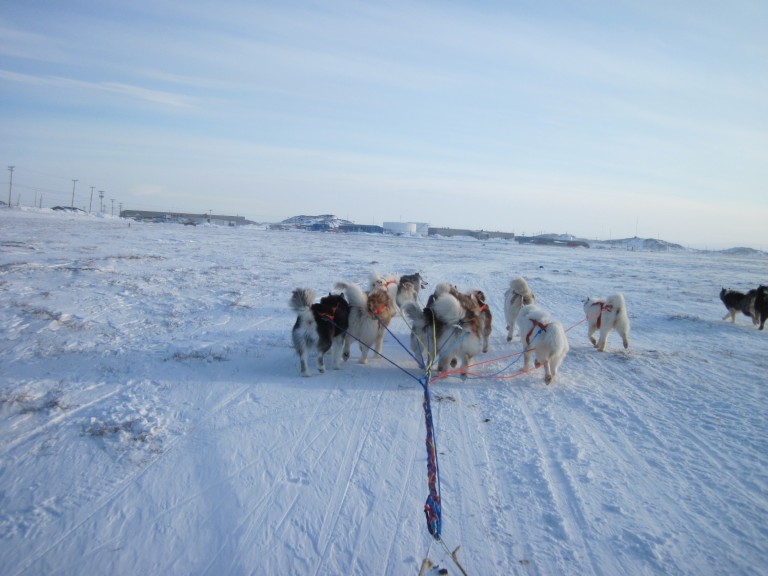

Good luck man! Youre an inspiration to everyone!
LikeLike
Train hard, but take care.
LikeLike
your poor flatmate! ;op
LikeLike
Well said my friend and best wishes for your endeavor.
For honor and glory
Eidik
LikeLike